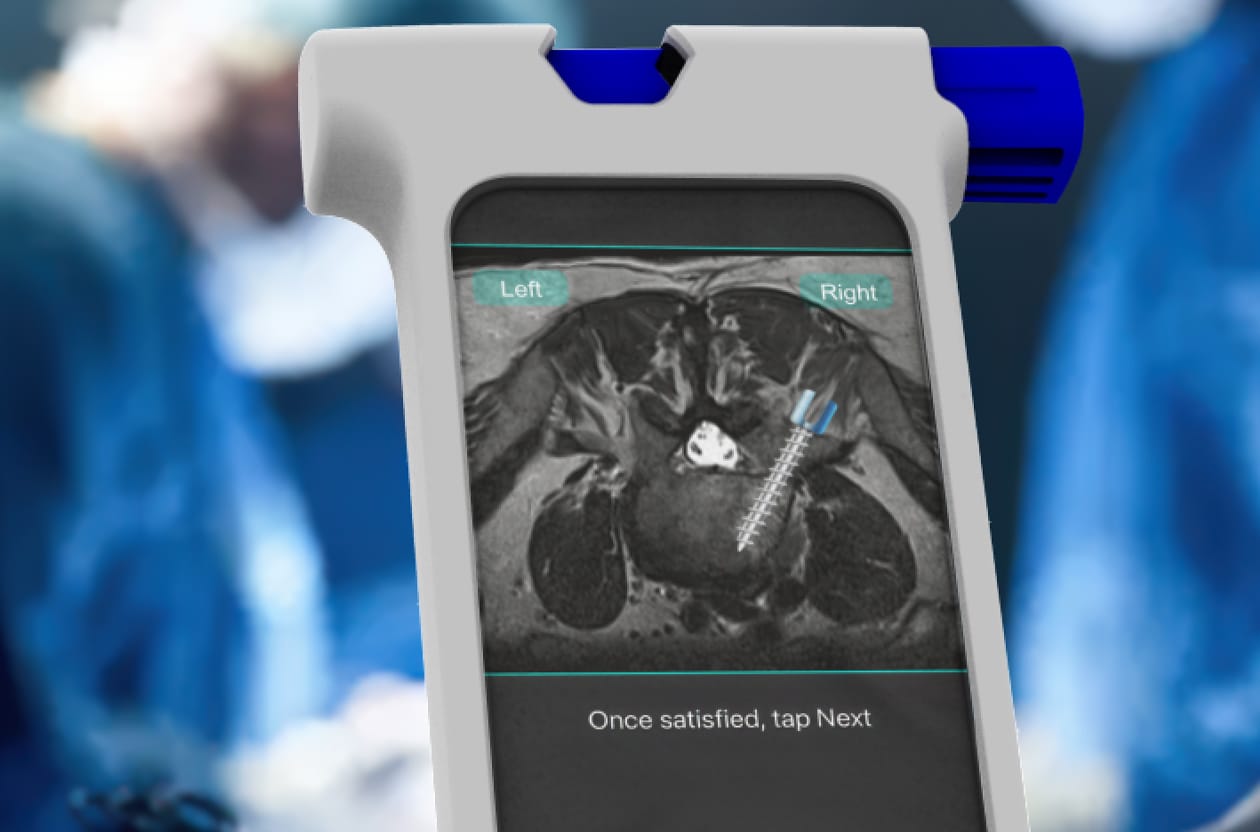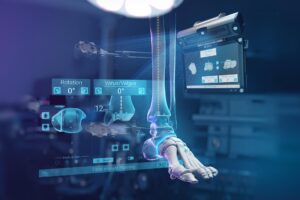
The evolution of orthopedic robots generates headline-grabbing attention, but advanced surgical navigation systems are playing just as important a role in pushing what’s possible in performing pinpoint joint replacement and spinal surgeries.
Consider that about 20% of joint replacement procedures involve the use of navigation and only 11% employ robotics. Plus, ORTHOWORLD Senior Market Analyst Mike Evers expects most orthopedic procedures will eventually involve digital preoperative planning and believes that adoption of augmented reality (AR) navigation systems will help drive the widespread use of enabling technologies.
Several companies recognize the significant growth potential of surgical navigation and are pushing the technology forward with advanced platforms. New technologies empower surgeons to perform surgeries with greater precision that result in fewer complications and improved patient outcomes.
Sleek New Options
Most surgical navigation systems rely on tracking pins and arrays to guide instruments during surgery. These systems are effective but depend on fixed markers to determine the position of bones and surgical tools.
VISIE’s Continuous Anatomic Auto Tracking (CAAT) technology eliminates the need for traditional tracking pins and arrays. Instead, it uses digital scanners that capture hundreds of thousands of data points within a fraction of a second. These data points can be quickly registered to a CT scan, allowing the VISIE system’s 3D scanners to track the femur or tibia in real-time as they move during surgery.
CAAT technology also ensures that the arm of an integrated surgical robot moves in sync with the knee’s natural motion. VISIE leveraged its expertise in 3D computer vision and spatial computing to develop the CAAT capabilities, which could enhance the precision of joint replacement surgeries. This innovation has the potential to improve surgical outcomes by offering more precise knee alignment and reducing the need for manual adjustments during surgery.
The ability to track anatomy without reliance on fixed arrays is a potential difference-maker in joint replacement procedures, according to J. Craig Morrison, M.D., an orthopedic surgeon at Southern Joint Replacement Institute in Nashville. He emphasized the transformative potential of the CAAT technology, comparing its functionality to the natural way humans track movement.
“If we had robotic systems that could actually see the patient, much like we do with our own eyes, and track the anatomy continuously throughout the procedure, that would be a game-changing development,” Dr. Morrison said. “It could mean avoiding pins and arrays, saving steps, time and tissue.”
VISIE has not yet submitted CAAT for FDA evaluation and is actively working on performance validation.
Bolt Navigation’s 2.0 system is designed to improve the accuracy of implant placement in open and minimally invasive spinal procedures. According to the company, the system matches the performance of legacy CT-based navigation with a significant reduction in radiation exposure for patients and surgical teams. By minimizing the need for CT scans or multiple intraoperative x-rays, Bolt 2.0 offers significant savings for hospitals and ASCs, making it a cost-effective option to improve surgical outcomes.
Bolt 2.0 leverages the iPhone as the core hardware platform. Tapping into the iPhone’s UX design and accessibility aims to address the challenges that spinal surgeons face when adopting new technologies.
Patrick West, Bolt Navigation CEO, emphasized that matching the performance of traditional navigation systems through an iPhone interface is a key selling point. “It’s our mission to make these best practice technologies available in every surgery,” he said. “That’s an important ethos for our company.”
Traditional C-arm-guided implant placement can involve 50-plus x-rays, according to West. He said Bolt 2.0 works in conjunction with a patient’s existing preoperative diagnostic MRI, so additional imaging isn’t needed. He added that a single x-ray taken at the beginning of the case is often enough to provide the platform with the necessary navigation telemetry.
Bolt 2.0 also allows for a more efficient approach to intraoperative navigation, potentially letting surgeons complete procedures in a shorter amount of time.
“Quicker cases result in less blood loss, lower infection risk and less exposure to anesthesia, all of which are well documented to be beneficial for the patients and the healthcare system,” West said.
Armed with what West calls “strong” clinical data, Bolt Navigation is working with a select number of surgeons who it hopes will act as key opinion leaders during efforts to educate the masses about the benefits of the technology.
“We’re allowing surgeons to place implants as accurately as they can with traditional navigation systems,” West explained. “But they can do it without the additional radiation associated with multiple intraoperative x-rays or CT scans.”

Exactech GPS for total ankle replacement surgery provide surgeons with real-time planning and surgical plan execution capabilities.
Complex Surgery Made Easier
C.J. Wittus, Director of Marketing at Exactech, said real-time navigation provides surgeons with detailed insights into joint spaces, which enhance their decision-making and accuracy and optimize surgical strategies. He believes the technology is evolving into the standard of care.
Digital ecosystems of integrated navigation technologies empower surgeons throughout the surgical process, from preoperative planning to precise intraoperative execution. “Our navigation platforms are built with the surgeon in mind,” Wittus said, “giving them greater control and confidence during procedures.”
Exactech’s GPS Ankle computer-assisted navigation platform is compatible with the company’s Vantage Total Ankle System and Active Intelligence ecosystem of enabling technologies, which includes GPS Shoulder and GPS Knee. The latest addition to the GPS family provides intraoperative navigation for total ankle replacement with trackers that register bones and guide surgeons to precise implant placement in real time.
Edward Haupt, M.D., of Mayo Clinic in Jacksonville, performed the first case that employed the technology last December. The surgery demonstrated the ways the platform makes technically challenging ankle replacements more reproducible. “Technology that simplifies the surgical process and improves intraoperative visualization has the potential to improve outcomes,” said Dr. Haupt, who helped design GPS Ankle.
According to Dr. Haupt, the navigation system offers even more precision and accuracy than traditional patient-specific instruments with the added advantage of allowing for flexibility during surgery. This adaptability allows surgeons to adjust the surgical plan as the procedure progresses based on the anatomy of individual patients.
GPS Ankle can track the joint’s range of motion and soft tissue balancing in real time, which Dr. Haupt believes could prove to be extremely valuable for surgeons. “I don’t think we fully understand how to interpret or use that data just yet,” he said, “but it’s fascinating and will almost certainly be helpful to know.”
In the past, surgeons depended on fluoroscopic images to verify implant positioning. Dr. Haupt contrasts this process with computer navigation, which provides data-driven guidance, reduces the need for fluoroscopy and leads to more accurate implant alignment. By using trackers and probes to align the patient’s real anatomy with a preoperative CT scan in a 3D coordinate system, GPS Ankle also ensures that surgical tools, such as cutting guides, are placed exactly where they need to be.
Dr. Haupt said these capabilities improve upon traditional methods in which surgeons relied on direct visualization and fluoroscopy to maneuver instruments and estimate precise placement of tools and implants. “GPS Ankle will hopefully have every step of the case navigated so it could be performed with minimal reliance on fluoroscopy,” Dr. Haupt said. “That’s the proximal goal.”
Computer-assisted navigation systems interface with preoperative data to template precise surgical plans. Surgeons have been mapping surgical approaches for decades, but advances in planning and navigation systems allow for a much more immersive process so surgeons can virtually perform the important parts of the surgery ahead of time.
“Each patient’s anatomy is unique, and the templating process allows for more accurate placement of implants,” Dr. Haupt said. “Computer-assisted navigation allows surgeons to more accurately execute on the surgical plan.”
Ankle replacement is a complex procedure that requires a lot of expertise and interpretation of imaging and surgical anatomy. The learning curve to effectively complete the procedure is smaller for surgeons who work with systems that provide actionable information during the procedure, according to Dr. Haupt. “Patient-specific instruments were a huge leap forward,” he said, “and navigation is the next natural step, just as it was in the other joints.”
Surgical navigation systems help surgeons solve the hard problems of surgeries, according to Dr. Haupt. “That’s better for the patient and decreases stress and mental burden for the surgeon,” he said, “so everyone wins.”
PM
Patrick McGuire is a BONEZONE Contributor.




